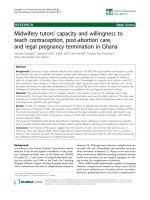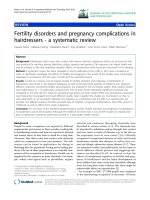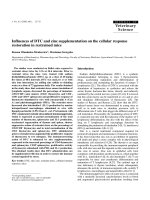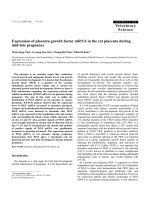Late pregnancy allowances in does on Haemato biochemical response in kids
Bạn đang xem bản rút gọn của tài liệu. Xem và tải ngay bản đầy đủ của tài liệu tại đây (172.71 KB, 6 trang )
Int.J.Curr.Microbiol.App.Sci (2019) 8(2): 3416-3421
International Journal of Current Microbiology and Applied Sciences
ISSN: 2319-7706 Volume 8 Number 02 (2019)
Journal homepage:
Original Research Article
/>
Late Pregnancy Allowances in Does on Haemato Biochemical
Response in Kids
S. Sahu1, L.K. Babu2, Archana Sarangi3*, Amit1 and D.K. Karna4
1
2
Department of LPM, LUVAS, Hisar, Haryana, India
Department of LPM, 4Department of AGB, OUAT, Bhubaneswar, Odisha, India
3
Division of Animal Physiology, NDRI, Karnal, Haryana, India
*Corresponding author
ABSTRACT
Keywords
Concentrate,
Pregnancy, Doe,
Blood profile, Kids
Article Info
Accepted:
26 January 2019
Available Online:
10 February 2019
Forty five extensively reared pregnant Ganjam does were randomly distributed into three
treatment groups (T1, T2, T3), 15 in each for evaluating the effect of late pregnancy
allowances to them on haemato-biochemical profiles of their kids. All the does were
maintained on browsing besides additional concentrate supplementation @ 200 g /day and
@ 300 g/day in T2 and T3, respectively. Additional allowances were fed to the treatment
groups 2 months prior to the expected date of kidding. Immediate after kidding, blood
samples were collected from the day old kids for analysis of hemoglobin, PCV, TEC,
MCV, MCH, MCHC, TLC, serum glucose, urea, total protein, albumin, globulin, A:G,
cholesterol, triglyceride, urea and creatinine. The lambs in T 2 and T3showed significantly
(P<0.05) higher haemoglobin (g/dl) (T 2: 9.95 ± 0.18; T3: 9.84 ± 0.30) and PCV % (T 2:
29.59 ± 1.16; T 3: 29.04 ± 1.32) than those in T 1 group. Other haematological parameters
remained statistically similar (P>0.05) between groups. Significant differences (P<0.05)
were observed for serum glucose in T 2 (56.94 ± 1.46 mg/dl) and T 3 (55.99 ± 1.32mg/dl)as
compared to T1 (49.82 ±2.16 mg/dl).For both total protein and albumin (g/dl), T 2 (8.59 ±
0.06 and 4.34 ± 0.04) and T3 (8.97 ± 0.04 and 4.66 ± 0.08) showed significantly (P<0.05)
higher value than T1 (7.15 ±0.04 and 3.14 ±0.11) while serum globulin remained
statistically similar between groups. Other Serum biochemical parameters were found to
be non significant (P>0.05) among groups. It was concluded that late pregnancy
allowances @ 200 g/day/doe in extensively reared does is required to maintain the glucose
and protein level in day old kids, may help for their further growth.
Introduction
Ganjam goat sometimes called as “Golla
goat‟ locally, is distributed in eastern region
of India and specifically in the whole of
Ganjam district along with parts of Gajapati
district of southern Odisha (Sahu et al., 2013).
Justifying Indian goats as “poor man‟s cow”,
this breed has been a major source of
livelihood of Golla tribe of its native tract
3416
Int.J.Curr.Microbiol.App.Sci (2019) 8(2): 3416-3421
since generations. These goats are reared
under extensive system of management
without any supplementary feed. Nearby
range and forest land mostly serve as the feed
source for these goats (Sahu et al., 2015).
Nutritional inadequacy in the extensive
system specifically to the pregnant does is a
major challenge. Rapid rate of foetal growth
during the final 6-8 weeks of pregnancy
imposes a metabolic challenge to the doe
which is met by the mobilisation of maternal
body tissue (Osuagwuh and Aire, 1990) and
this may result in weight loss of doe if the
dietary supply of nutrients is inadequate
(Martin et al., 2005 and Rafiq et al., 2003).
An increased plane of nutrition during late
gestation has been reported to have various
advantages, such as; reduced incidence of
pregnancy toxaemia (Fraser et al., 1938;
Charismiadou et al., 2000), less metabolic
stress (Kerslake et al., 2010). Some
encouraging results have been obtained by
many workers by prepartum supplementation
(Chaturvedi et al., 2008 and Dawson et al.,
2005). Besides the above benefits, maternal
nutrition significantly affect the birth weight
of kids (Sahu et al., 2018) which in-turn
maintain proper pre-weaning growth and
good health of kid. Nutrition of dam during
pregnancy influences blood metabolites of
kids which serve as an excellent tool for
prediction of the metabolic status of animal
and their future performance. Considering the
above facts in mind the present study was
undertaken to study the effect of late
pregnancy allowances in does on haemato
biochemical response in kids.
Materials and Methods
The present investigation was carried out in
Chhatrapur block of Ganjam district of Orissa
where AICRP on Goat Improvement (Ganjam
Field Unit) is operating. These areas are
dominated by „Golla‟ people, who rear
Ganjam goats traditionally in large number in
range system. The animals selected were from
the flocks of registered goat farmers of the
project. For this study, pregnant does of
similar body weight (33.91 ± 0.70 kg to 34.59
± 0.75 kg), age and parity (3rd to 5th parity)
were selected. The expected dates of kidding
were estimated as per the breeding history of
goat given by the flock man. A total of 45
healthy pregnant does were taken for this
study. The selected does were randomly
allotted to three treatment groups based on
complete
randomized
design,
each
compromising 15 pregnant does and kept in
different feeding regimens viz. (T1): Control;
normal browsing at range system; (T2):
Control with daily supplementation of 200 g
concentrate mixture and (T3): Control with
daily supplementation of 300 g concentrate
mixture. This concentration mixture contained
22% crude protein (estimated) with 72% Total
Digestible Nutrients (calculated). Concentrate
feeding was done in very early morning by
confining the goats in partition wall made up
of bamboo and taken to the nearby forest
thereafter, for the purpose of browsing
(Average duration was 8hours, from 9am to
4pm) as it was a routine practice of the flock
man. Concentrate feeds were offered upto
parturition and average daily Dry Matter
Intake (DMI) was 163 g/doe/day and 224.0
g/doe/day in T2 and T3 respectively.
Immediate after kidding, blood samples were
collected from the kid by jugular vein
puncture before suckling.
For estimation of haematological parameters
like Haemoglobin, Haematocrit (PCV), TEC,
MCV, MCH, MCHC and TLC, 2 ml blood
collected in blood collection tube containing
EDTA as described by Benjamin (1985). For
analysis of biochemical parameters, 6 ml
blood was collected in sterilized dry
centrifuge tubes and kept in slanted position
at room temperature for some time and
centrifugation was done at 5000rpm for 10
minutes at 4oC. The supernatant (serum) was
3417
Int.J.Curr.Microbiol.App.Sci (2019) 8(2): 3416-3421
separated in airtight serum storage vials and
kept at -20oC till analysis of biochemical
parameters. Analysis was done after thawing
for various biochemical profiles (total protein,
albumin,
globulin,
urea,
creatinine,
cholesterol and triglyceride) except glucose
which was done soon after collection of
serum, as per the standard protocol.
Data, thus obtained were subjected to suitable
statistical analysis following standard
methods described by Snedecor and Cochran
(1994) using the SAS 9.2 package.
Results and Discussion
As a means of metabolic indicator in the new
born kids and their future performance, the
effect of late pregnancy allowances in does on
haemato biochemical response in kids are
presented in table 1 and 2. The haemoglobin
level ranged from 9.01±0.21 to 9.95±0.18 g/dl
in various treatment groups under study. Kids
in T2 (9.95±0.18 g/dl) and T3 (9.84±0.30 g/dl)
showed significantly (P<0.05) higher
haemoglobin than those in T1 group
(9.01±0.21 g/dl) (Table 1). Similar to the the
above findings, kids under T1 group showed
significantly lower PCV (26.01 ±1.48%) as
compared to T2 (29.59 ± 1.16%) and T3 (29.04
± 1.32%). For both the parameters, kids under
T2 and T3 revealed statistically similar result.
No significant variation was observed
between groups for the other haematological
parameters viz. Total Erythrocyte Count
(TEC: 12.89 ± 0.47 to 13.12 ±0.39), Total
Leucocyte Count (TLC:7.98 ± 0.31 to 8.19
±0.25),
Mean
Corpuscular
Volume
(MCV:19.41 ±0.89 to 20.15 ± 0.65), Mean
Corpuscular Haemoglobin (MCH: 8.31 ± 0.12
to 8.54 ±0.14) and Mean Corpuscular
Haemoglobin Concentration (MCHC: 30.54 ±
1.68 to 32.14 ± 2.76) (Table 1). Decreased
concentration of Hb and PCV % in kids under
extensively reared groups could be due to the
fact that non supplementation of the does with
concentrate mixture during pregnancy limits
the normal physiological function and
decrease the PCV and Hb values in the blood
of day old kids (Sahoo et al., 2016). Serum
glucose level in the day old kids after 60 days
of feeding trial to their dams ranged between
49.82 ±2.16 to 56.94 ± 1.46 mg/dl in the
different treatment groups under study (Table
2). The glucose concentrations recorded in the
present study is well within the normal range
of 45-60 mg/dl (Altman and Dittmer, 1961)
but lower than 63.35 ± 7.70 mg/dl (Sandabe
et al., 2004). This might be due to the
differences in breed, environment and
nutritional status of the experimental animals
in the two studies.
A significantly higher value of serum glucose
in T2 (56.94 ± 1.46 mg/dl) and T3 (55.99 ±
1.32mg/dl) as compared with T1 (49.82 ±2.16
mg/dl) might be due to the effect of
concentrate supplementation resulting in
production of higher amount of propionate, a
gluconeogenic substrate, in the rumen
fermentation resulting in elevated serum
glucose as reported by Thomas et al., (1988)
which somewhat compensates the extra
energy required by the growing foetus, in-turn
might enhance the blood glucose level in the
day old kid at birth.
The average serum total protein ranged from
7.15 ±0.04 to8.97 ± 0.04 g/dl during the
experimental period in the three treatment
groups of Ganjam goats. The result of the
present study was in agreement to the value of
Kumar et al., (2008) and Kaushik and Bugalia
(1999). These differences might be due to the
effect of breed, environment and nutritional
status of the experimental animals in the
above studies. For both total protein and
albumin (g/dl), T2 (8.59 ± 0.06 and 4.34 ±
0.04) and T3 (8.97 ± 0.04 and 4.66 ± 0.08)
showed significantly (P<0.05) higher value
than T1(7.15 ±0.04 and 3.14 ±0.11). In
between two supplemented groups, T3 were
found to have more value as compared to T2.
3418
Int.J.Curr.Microbiol.App.Sci (2019) 8(2): 3416-3421
Table.1 Effect of late pregnancy allowance of does on haematological profiles in kids
Parameters
T1
T2
T3
Haemoglobin (g/dl)
9.01 ±0.21B
9.95 ± 0.18A
9.84 ± 0.30A
Packed Cell Volume (%)
26.01 ±1.48B
29.59 ± 1.16 A
29.04 ± 1.32 A
Total Erythrocyte Count (106/µl)
13.12 ±0.39
12.89 ± 0.47
12.91 ± 0. 51
Total Leucocyte Count (103/µl)
8.07 ±0.18
7.98 ± 0.31
8.19 ± 0.25
Mean Corpuscular Volume (fL)
19.4 ±0.89
20.15 ± 0.65
19.87 ± 1.04
Mean Corpuscular Haemoglobin (pg)
8.54 ±0.14
8.32 ± 0.38
8.31 ± 0.12
Mean Corpuscular Haemoglobin
31.80±2.10
30.54 ± 1.68
32.14 ± 2.76
Concentration (g/dl)
Means with different superscripts in a row (A,B) differ significantly (P<0.05).
Table.2 Effect of late pregnancy allowance of does on blood biochemical profiles in kids
Parameters
T1
T2
T3
Glucose (mg/dl)
49.82 ±2.16B
56.94 ± 1.46A
55.99 ± 1.32 A
Total Protein (g/dl)
7.15 ±0.04C
8.59 ± 0.06B
8.97 ± 0.04A
Albumin (g/dl)
3.14 ±0.11C
4.34 ± 0.04B
4.66 ± 0.08 A
Globulin (g/dl)
4.02 ±0.16
4.25 ± 0.09
4.31 ± 0.21
A/G ratio
0.78 ±0.05B
1.02 ± 0.03A
1.08 ± 0.07A
Urea (mg/dl)
23.98±1.58
25.18 ± 0.95
24.91 ± 1.36
Creatinine (mg/dl)
0.61±0.03
0.59±0.05
0.65±0.03
Cholesterol (mg/dl)
72.45±3.58
69.94±5.08
70.76±3.97
Triglyceride (mg/dl)
33.57±2.11
34.81±2.95
31.79±3.08
Means with different superscripts in a row (A,B,C) differ significantly (P<0.05).
Significantly
higher
total
protein
concentrations were observed in kids of
supplemented ewes suggesting that improved
nutritional status in T2and T3 does (Sahoo et
al., 2016) might have resulted in more
nutrients availability for the foetus in turn in
day old kids. Contrary to the above protein
parameters, serum globulin concentration
(g/dl) was statistically similar (P>0.05) in T1
(4.02 ±0.16),T2 (4.25 ± 0.09) and T3(4.31 ±
0.21), however it remained within the normal
physiological
range.
Non
significant
difference in serum globulin concentration in
different groups might be due to inability of
the immunoglobul into cross the placental
barrier (Castro et al., 2011). The mean serum
A/G ratio was statistically higher (P<0.05) in
T2 (1.02 ± 0.03) and T3 (1.08 ± 0.07) as
compared to T1 (0.78 ±0.05). Significant
difference in A/G ration is due to a significant
3419
Int.J.Curr.Microbiol.App.Sci (2019) 8(2): 3416-3421
increase in albumin concentration in
supplemented groups as compared to non
supplemented groups. The values for other
serum biochemical values (Table 2) viz. urea
(23.98±1.58 in T1 to 25.18 ± 0.95 mg/dl in
T2), creatinine (0.59±0.05 in T2 to 0.65±0.03
mg/dl in T3), cholesterol (69.94±5.08 in T2 to
72.45±3.58 mg/dl in T1) and triglyceride
(31.79±3.08 in T3 to 34.81±2.95 mg/dl T2) did
not show any significant difference (P>0.05)
between the groups, but were in line with
standard values of the available literature.
It can be concluded that an extra allowances
of concentrate @200g/day/doe besides normal
browsing to the pregnant doe improved birth
weight and metabolic profile of kids.
Acknowledgement
Authors are highly thankful to Vice
Chancellor and OIC, AICRP on Goat
Improvement, O.U.A.T., Bhubaneswar for
providing all the facilities to carry out this
research work at Ganjam, Odisha, India.
References
Altman, P.L., and Dittmer, D.S. 1961. Blood
and other body fluids. 1st edition, Fed.
Am. Soc. Exp. Biol., Washington.
Castro, N., Capote, J., Bruckmaier, R.M. and
Argüello, A. 2011. Management effects
on colostrogenesis in small ruminants: a
review. J. Applied Anim. Res., 39:2, 8593,
DOI:
10.1080/09712119.2011.581625.
Charismiadou, M.A., Bizelis, J.A. and
Rogdakis, E. 2000. Metabolic changes
during the perinatal period in dairy
sheep in relation to level of nutrition
and breed. I. Late pregnancy. J Anim.
Physiol. Anim. Nutr., 84(3-4): 61-72.
Chaturvedi, O.H., Verma, D.L., Singh, N.P.
and Man, J.S. 2008. Effect of
concentrate
supplementation
on
production performance of ewes grazing
on community rangeland. Indian J.
Anim. Sci., 78(10): 1162.
Dawson, E.R., Carson, A.F., Kilpatrick, D.J.
and Laidlaw, A.S. 2005. Effect of
herbage allowance and concentrate food
level offered to ewes in late pregnancy
on ewe and lamb performance. Brit.
Soc. Anim. Sci., 81: 413.
Fraser, A.H.H., Godden, W., Snook, L.C. and
Thomson, W. 1938. The influence of
diet upon ketonaemia in pregnant ewes.
J., Physiology., 94: 346-357.
Ingvartsen, K.L. 2006. Feeding and
management related diseases in the
transition cow. Physiological adaptions
around calving and strategies to reduce
feeding-related diseases. Anim. Feed
Sci. Techno., 126: 175-213.
Kaushik, H.K. and Bugalia, N.S. 1999.Plasma
total protein, cholesterol, minerals and
transminases during pregnancy in goats.
Indian Vet. J. 76: 603-606
Kerslake, J.I., Kenyon, P.R., Morris, S.T.,
Stafford, K.J. and Morel, P.C.H. 2010.
Does offering concentrate supplement
during late pregnancy affect twin- and
triplet- bearing ewe and lamb
performance? New Zeal J. Agr. Res.,
53(4): 315 – 325.
Kumar. P., Roy, N. and Mishra, S.N. 2008.
Studies
on
changes
in
haematobiochemical
values
under
different physiological stresses of goats.
Royal Vet.J.India.4: 53-56
Martin, G.B., Rodger, J. and Balache, D.
2005. Nutritional and environmental
effect on reproduction in small
ruminants. Repro.fertility Dev.16: 491501.
Osuagwuh, A.I.A. and Aire, T.A. (1990).
Intra uterine growth rates of the West
Africa an dwarf goats and some fetal
organs in relation to strategic feed
supplementation during pregnancy. J.
Vet. Med., 37: 198.
3420
Int.J.Curr.Microbiol.App.Sci (2019) 8(2): 3416-3421
Rafiq, M., Khan, M.F. and Aujla, K.M.
(2003). Economic benefits of lushing
and supplemental feeding of salt-range
ewes on pothwar ranges of Pakistan.
Pakistan J. Biol. Sci., 6: 115.
Sahoo, C., Pradhan, C.R., Sahu, S., Kumari,
A. and Sarangi, A. 2016. Growth and
haemato-biochemical response in lambs
in relation to supplementary feeding of
ewes in late pregnancy. Ind. J. small
Rumin., 22 (2): 249-251.
Sahu, S., Babu, L.K., Karna, D.K., Behara,
K., Kanungo, S., Kamal, R. and
Upadhyay, D. 2015. Effect of prepartum
supplementation on blood biochemical
profiles of pregnant Ganjam goats.
Indian J. Anim. Res., 49 (4): 487-490.
Sahu, S., Babu, L.K., Karna, D.K., Behara,
K., Kanungo, S., Kaswan, S., Biswas, P.
and Patra, J.K. 2013. Effect of different
level of concentrate supplementation on
the periparturient growth performance
of Ganjam goats in extensive
system.Vet. World, 6 (7): 428-432.
Sahu, S., Babu, L.K., Sarangi, A.,
Ajithakumar,
H.M.
and
Karna,
D.K.2018. Effect of steaming-up on the
growth performance of kids and
economics in extensive rearing system.
Haryana Vet., 57 (1): 80-82.
Sandabe, U.K., Mustapha, A.R. and Sambo,
E.Y. 2004. Effect of pregnancy on some
biochemical parameters in Sahel goats
in semi arid zones. Vet. Res. Comm.,28:
279-285.
Snedecor, G.W. and Cochran, W.G. 1994.
Statistical methods.8th edition. Iowa
State University Press, Ames, Iowa.
Thomas, V.M., McInerny, M.J. and Kott,
R.W. 1988. Influence of body
conditions and lasolacid during late
gestation on blood metabolites, lamb
birth weight, colostrums consumption
and production in Finn cross ewes. J.
Anim. Sci. 66: 1183-1191.
How to cite this article:
Sahu, S., L.K. Babu, Archana Sarangi, Amit and Karna, D.K. 2019. Late Pregnancy
Allowances in Does on Haemato Biochemical Response in Kids. Int.J.Curr.Microbiol.App.Sci.
8(02): 3416-3421. doi: />
3421









